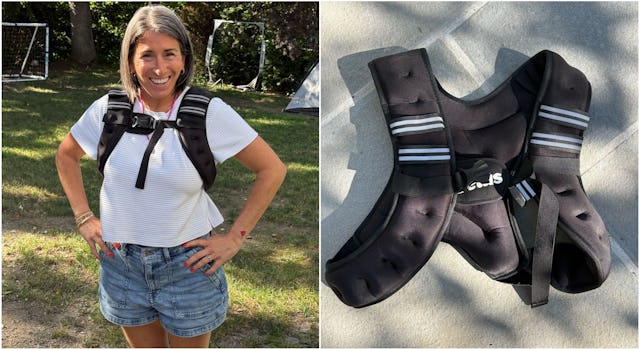OK, Why Are We *Really* Wearing Weighted Vests?
Is it actually doing anything other than making us feel like we're part of a trend?

They are popping up everywhere on your social media feeds — women wearing what looks like tactical gear, swearing up and down that their new weighted vest is the absolute best part of their routine. Some reels show women wearing weighted vests as they wash dishes at their sinks; others show women wearing them for a “hot girl walk” or strapping them on before hopping on a gym treadmill.
It’s the latest health and fitness craze, but one that sounds like it could actually work. What do weighted vests really do for women, though? Is it just another Amazon purchase to help you burn a few extra calories, or are there deeper and more meaningful benefits to looking a little like you’re planning to go off the grid as you walk around your neighborhood listening to a podcast?
Why not both?
The thing about the weighted vest is that it is only a useful tool when used with “the right goals, context, and guidance, especially for women focused on bone health, posture, metabolism, and functional strength,” says Dr. Mark Kovacs, PhD, FACSM, CSCS, a performance physiologist and former VP of Health & Performance at Canyon Ranch. “Weighted vests are not a gimmick, but they also aren’t a one-size-fits-all solution.”
Do weighted vests help burn calories?
There are some dubious claims out there from TikTok influencers who really want you to buy a weighted vest from their affiliate storefront, but let’s make it clear: While a weighted vest can help you burn more calories, it’s probably not as much as you’re thinking. “While a weighted vest can increase energy expenditure, for walking-based activities, the boost is typically around 8 to 12%,” says Kovacs. If you want to burn extra calories, he says the key is consistency — not just added load. One walk a week with your weighted vest on isn’t going to suddenly drop a dress size, you know?
Do weighted vests help with your core muscles and posture?
For this potential benefit, Kovacs says the extra load of a weighted vest does encourage “upright posture and core stabilization,” particularly when worn during exercises like squats or stair climbing. “It acts as a feedback tool to build body awareness and balance.” But remember, it’s not just the magic of the vest — it’s how your body reacts to wearing it, so being mindful of how you feel and how the vest works will help you reap those benefits.
Do weighted vests offer bone density support?
If this is why you’ve been wearing your vest, well then give yourself a round of applause. According to Kovacs, bone density support is a major benefit of wearing a weighted vest, especially for post-menopausal women. “Weighted vests apply gentle load to the spine and hips during walking or bodyweight movement, which can help stimulate osteogenic response — critical for preserving bone density as estrogen declines. This is supported by multiple studies showing improvements in bone mineral density (BMD) when used in weight-bearing routines.” So strap up, babe, we’re growing some strong bones here.
Are there any cons to wearing a weighted vest?
Like any kind of fitness or health regime, not everything is for everybody. Kovacs warns that individuals with joint issues, particularly in the knees or lower back, should be cautious when using a weighted vest, as improper use can exacerbate symptoms. He recommends starting with a lightweight load — around 4 to 10% of your body weight — and avoiding high-impact movements while wearing it until your body adapts.
“If the vest is poorly fitted or overly tight, it can increase intra-abdominal pressure and interfere with diaphragmatic breathing — important to monitor in postpartum or pelvic floor-sensitive populations,” he says. He also notes that weighted vests are not ideal for every workout, and using them during HIIT, jumping, or dynamic sports without proper prep can elevate your injury risk.
Instead, try adding a weighted vest to your daily walks or incline walking for “low-impact bone loading.” Kovacs also suggests wearing them during bodyweight resistance training, such as squats, lunges, or push-ups, to challenge your body. “Rotate weighted vest use with restorative and mobility work to avoid overloading the central nervous system or joints,” he adds.
“For women, especially midlife and beyond, weighted vests can be a strategic way to enhance musculoskeletal health and metabolic resilience when integrated thoughtfully into a balanced training plan,” Kovacs adds. So this may be one trend worth keeping around — as long as we do it correctly.